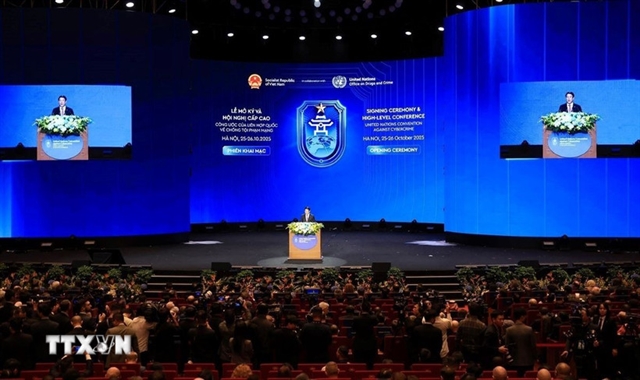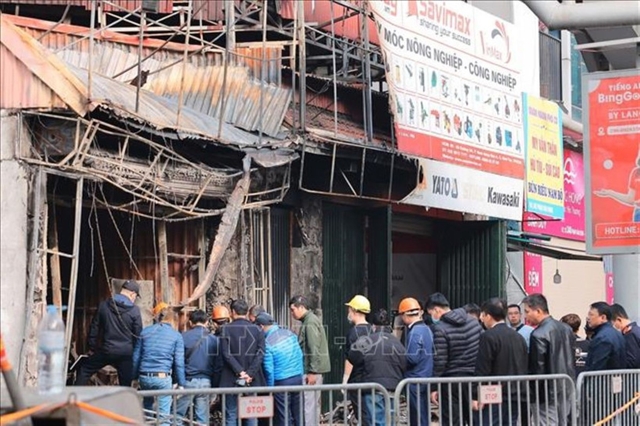 Economy
Economy

Thailand’s plan to accelerate sales of 11.4 million tonnes of rice in stockpiles within two months sparked concerns that it would hurt prices as well as Việt Nam’s rice exports. However, some people were optimistic that the impact would not be significant.
 |
| Rice packs are loaded at Đồng Tháp Food Company. Thailand’s plan to sell 11.4 million tonnes of rice in May and June sparked concerns about the impact it would have on Việt Nam’s rice exports, but some said the effects would not be significant. – VNA/VNS Photo Vũ Sinh |
HÀ NỘI – Thailand’s plan to accelerate sales of 11.4 million tonnes of rice in stockpiles within two months sparked concerns that it would hurt prices as well as Việt Nam’s rice exports. However, some people were optimistic that the impact would not be significant.
Thailand planned to sell all 11.4 million tonnes of rice in a government stockpile in May and June to generate US$2.8 billion, in what could be the biggest rice sale clearance ever of the world’s second largest rice exporter after India.
According to Lê Văn Bảnh, director of the Department of Agro-Fisheries Processing and Salt Production, the biggest stockpiled rice sell-off from Thailand would certainly have an impact on the global rice market following the law on supply and demand, as well as on Việt Nam’s rice market.
However, the impact on Việt Nam’s rice exports would not be significant, at least in the short term, Bảnh said.
Bảnh also said that Thailand’s plan to sell 11.4 million tonnes of rice within just two months was not feasible.
He said that Thailand exported on an average 400,000 tonnes to 500,000 tonnes of rice per month. “To sell 11.4 million tonnes in just two months sounds unrealistic,” Bảnh said as quoted by vietnamplus.vn.
The Việt Nam Food Association said that the impact on rice exports would not be huge in the second and third quarters as most contracts had been signed in the last quarter of 2015, and there were estimated to be 1.4 million tonnes of rice remaining to be shipped abroad following existing signed contracts.
According to Bảnh, the stockpiled rice for this clearance would mainly be “sub-standard” quality that the Thai government had purchased following the 2012-2013 rice mortgage programme and Thailand would target the not-too-demanding markets such as in Africa.
Since May 2014, Thailand has auctioned off 5.05 million tonnes of rice worth US$1.5 billion. The Thai government had previously said it aimed to clear the stockpile by the end of 2017.
Meanwhile, major import markets of Vietnamese rice were China, the Philippines and Indonesia which had standards for rice quality and preferred newly-harvested Vietnamese rice, he said. “Rice exports from Việt Nam would not be significantly affected by Thailand’s sell-off in the coming months,” he said.
According to Ma Quang Trung, director of the Plantation Department under the Ministry of Agriculture and Rural Development, Việt Nam’s rice exports in the first four months of this year reached 2.06 million tonnes, worth $916 million, rising by 11.8 per cent in volume and 13.8 per cent in value over the same period last year. Average rice export price was $438 per tonne, increasing by 0.32 per cent over the same period last year. China was the largest importer of Vietnamese rice, accounting for more than 30 per cent of the Việt Nam’s total rice exports.
Last year, Việt Nam was the third largest rice exporter in the world with an export volume of 6.4 million tonnes.
Close watch
According to Bảnh, the Ministry of Agriculture and Rural Development has asked the Việt Nam Food Association, rice companies and farmers to closely track movements in the global rice market, especially from Thailand’s clearance sale, for timely measures.
Nguyễn Văn Đôn, director of food trading company Việt Hưng in southern Tiền Giang Province, said the sale of Việt Nam’s sub-standard rice would be affected the most by Thailand’s move, as Thailand accelerated the stockpiled rice sale in the months coinciding with the rice harvest crop of Việt Nam
The Ministry of Industry and Trade said at the end of April, days after Thailand’s announcement, that the global rice market was seeing unpredictable developments, which would influence Việt Nam’s rice exports in 2016.
Besides export prices which no longer was of Vietnamese rice competitiveness, quality and brand were also matter of concerns in exports.
The ministry said that it was important to hasten the restructuring of the agricultural sector and rice production towards building up a value chain, enhancing quality and developing a Vietnamese brand.
Quality would help Việt Nam to compete and maintain markets amid the flurry of low-priced rice, an expert said.
The industry and trade ministry also said that it would enhance trade promotion to take advantage of the new-generation free trade agreements to expand rice export markets.
In addition, the ministry proposed to Prime Minister Nguyễn Xuân Phúc to provide preferential loans to rice traders for investments in warehouses and for buying rice from farmers in an effort to accelerate exports this year.
---- Inbox----
Building a national brand
Prime Minister Nguyễn Xuân Phúc approved the agriculture ministry’s proposal of a Vietnamese rice brand development and management master programme from combining five separate projects.
These projects were previously raised in the Prime Minister Decision 706/QĐ-TTg about developing rice brand issued in May 2015.
The master programme aimed to enhance the recognition of Vietnamese rice in the global market to boost competitiveness, improve rice added value and expand markets.
It would focus on developing a national rice brand name, brands for major rice products of Cửu Long (Mekong) Delta, the country’s biggest rice production area, rice brand protection, trade promotion and exports expansion.
Việt Nam aimed to become the world’s leading rice brand by quality and food safety by 2030, under the approved project. – VNS




